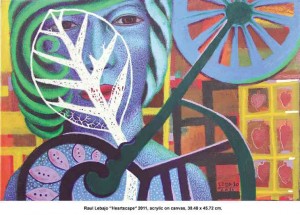
Raul Lebajo looks back at the past and peers into the future in his latest one-man show of large-scale portrait paintings, “Friends” (at Galleria Duemila until May 20).
The series features a haunting progression of faces produced from 2010 to 2013: multidimensional and dreamlike images culled from the artist’s own recollections and personal reflections.
Art critics have continually described Lebajo’s distinctive style as a painter as being strongly influenced by Abstract Expressionism and Surrealism, since the start of his art practice in the 1960s.
Over the decades, Lebajo has unfailingly produced a large body of work ranging from large-scale still lifes, scapes and portraits, to smaller pen-and-ink drawings on paper.
Asked about his subjects for this show, the artist says the portraits are based on people he has encountered over the years; this is his way of telling their stories and reflecting on what they mean to him.
“Friends” demonstrates how Lebajo has increasingly experimented with the genre of portraiture, responding and altering its conventions through his particular style.
There are no prominent personalities or famous figures acting as sitters in Lebajo’s paintings. Instead, he puts together massive canvases with anonymous, almost alien and humanoid visages, creating an entire array of faces from, but seemingly not of, this world.
Archetypal portraits
The show emphasizes how Lebajo unobtrusively challenges the conventions of his chosen subjects.
As a painting genre, academic portraiture has been traditionally associated with formality, stasis and patronage. Often commissioned by their sitters, the genre is one that aims to memorialize and edify, not to draw out contradictions.
The person portrayed is represented through the iconography of ceremony: the trappings of posture, dress and gesture. Lighting and backdrops often serve to complement these projections of both individual personality and social class. The visual appearance of the subject is treated as a largely one-dimensional plane, devoid of contradiction or rupture; the person is represented not as an individual but as an icon of a particular social order.
Lebajo treats portraiture as an extension of memory, a way of recollecting the essential. His portraits represent their subjects through a different manner: stylized, dreamlike and interspersed with other images denoting both natural and abstract forms.
However, it is impossible to conceive of Lebajo’s portraits as mere painterly snapshots of individuals, meant to represent the particular person’s own countenance and personality. For his works combine verisimilitude with the surreal, reality with the mythic.
Individual faces are shaped into archetypes and set in a parallel universe. They share space with the elements beyond the person represented, enveloped and interconnected with different organic shapes, patterns and grids.
Innate symmetry
Unlike conventional portraits, which usually identify the subjects portrayed, Lebajo remains cryptic in describing who the faces denote. Instead, he labels many of the works through archetypes and symbols.
“The Dreamer” (2012), for instance, depicts an unidentified woman enveloped by a translucent, circular mass. Built by white outgrowths reminiscent of fractals—the beautiful, innate symmetry of the natural world—the unnamed subject remains protected and cocooned in her reef of thoughts.
Other archetypes are similarly formed. “The Prince” (2012) is resplendent in its contrast of the royal countenance with the colors and patterns of flora and foliage. “Guardian” (2012) presents a green masked figure that seems simultaneously human and alien: a denizen inhabiting the world of fantasy.
The portraits are large in terms of scale, conveying the feeling of monumentality.
In this series, Lebajo also focuses on the intensity of the gaze: the eye in contact with that of the beholder. Even in subjects portrayed sideways and in profile, the eyes are represented as they would be in a frontal position: aimed straight at the viewer in front.
The combination of such visual devices all contribute to the drawing power of Lebajo’s images. The connection between image and viewer is concentrated in the singular moment of gazing at each other, closing the spaces and silences between.